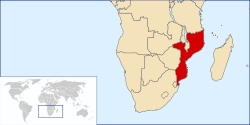Portuguese Mozambique
Portuguese East Africa África Oriental Portuguesa | |||||||||
|---|---|---|---|---|---|---|---|---|---|
| 1498–1975 | |||||||||
 Portuguese East Africa | |||||||||
| Status | Portuguese colony | ||||||||
| Capital | Lourenço Marques (Maputo) | ||||||||
| Common languages | Portuguese | ||||||||
| Head of state | |||||||||
• King 1498-1521 | Manuel I of Portugal | ||||||||
• President 1974-75 | Francisco da Costa Gomes | ||||||||
| Governor-general | |||||||||
• 1609-11 (first) | Nunho Álvares Pereira | ||||||||
• 1974-75 (last) | Vítor Crespo | ||||||||
| Captain-general | |||||||||
• 1569-73 (first) | Francisco Barreto | ||||||||
• 1607-09 (last) | Estévão de Ataíde | ||||||||
| Historical era | Imperialism | ||||||||
• Established | 1498 | ||||||||
• Fall of Portuguese Empire | 25 June 1975 | ||||||||
| Currency | Portuguese escudo | ||||||||
| ISO 3166 code | MZ | ||||||||
| |||||||||
Portuguese East Africa is the name formerly applied to a string of Portuguese overseas colonies along the south-east African coast, which now form the republic of Mozambique.
Portuguese trading settlements and, later, colonies were formed along the coast from 1498, when Vasco da Gama first reached the Mozambican coast. Some of these colonies were handed over in the late nineteenth century for rule by chartered companies such as the Companhia de Moçambique.
Portugal possessed the following colonies in the area, which were known collectively as Portuguese East Africa:
(From south to north)
- Lourenço Marques (now Maputo, the Mozambican capital city)
- Inhambane
- Manhica e Sofala (administered until 1942 by the Companhia de Moçambique)
- Quelimane and Tete (these last two were initially separate, then combined as Zambezia)
- Moçambique (now Nampula Province)
- Niassa (administered until 1929 by the Companhia de Niassa).
In 1951 the colonies were combined into a single overseas province under the name Moçambique. In many cases the colonies have given their names to the modern provinces of Mozambique.


